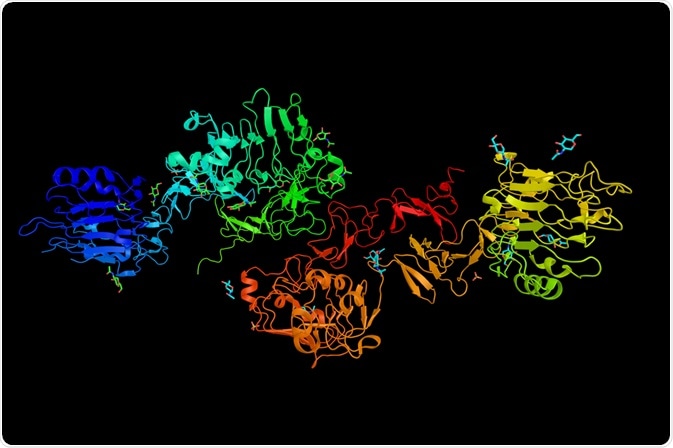The polybasic cleavage site is a proteolytic excision site utilized by cellular proteases that activate a wide range of precursor proteins. The acquisition of a polybasic cleavage site is associated with viral pathogenicity and virulence.
 Image Credit: ibreakstock/Shutterstock.com
Image Credit: ibreakstock/Shutterstock.com
What is a polybasic cleavage site?
Proteolytic excision at polybasic cleavage sites is a post-translational modification phenomenon required for the maturation and activation of several precursor proteins, including neuropeptides, peptide hormones, growth factors, membrane receptors, coagulation factors, and adhesion proteins.
Various cellular proteases such as furin, trypsin, cathepsin, and trans-membrane protease/serine that catalyze the proteolytic activation process are also known to cleave various viral cell surface proteins, which is required for the viral entry to host cells.
What are the consequences of the polybasic cleavage site in viruses?
A wide range of evidence indicates that the proteolytic cleavage of viral surface proteins at the polybasic cleavage site is essential for viral pathogenicity, virulence, and interspecies transmission.
Polybasic hemagglutinin cleavage site in influenza A virus
Hemagglutinin and neuraminidase are two glycoproteins on the cell surface of the influenza A virus, and depending on the antigenicity of these two proteins, influenza A virus is divided into many subtypes (hemagglutinin: H1 – H16; neuraminidase: N1 – N9). Hemagglutinin is responsible for the attachment and fusion of a virus with host cells.
The pathogenicity, virulence, and species-to-species transmission of influenza virus A, which is generally found in both avian and mammalian species, strictly depends on the nature of amino acids at the proteolytic cleavage site of hemagglutinin.
Among all highly pathogenic avian influenza viruses, H5 and H7 are the highly pathogenic subtypes responsible for the high death rate in poultries as well as interspecies transmission, such as bird to human transmission (H5N1 or H7N7 subtypes). Studies have suggested that the frequency of gaining highly pathogenic phenotypes is higher for H5 and H7 subtypes as they are genetically predisposed to acquire polybasic hemagglutinin cleavage sites.
Low-pathogenic influenza A virus contains only a single type of amino acid (arginine) at the hemagglutinin cleavage site, and trypsin-like proteases catalyze the proteolytic cleavage process, leading to mild, localized respiratory or intestinal infections.
However, these low-pathogenic viruses can be transformed into highly pathogenic viruses because of the acquisition of multiple basic amino acids at the hemagglutinin cleavage site (polybasic cleavage site). Furin and PC6 are the examples of ubiquitous proteases that recognize the polybasic cleavage site and catalyze the proteolytic cleavage of hemagglutinin, leading to severe systemic infection.
Various mechanisms are involved in the generation of a polybasic cleavage site. For example, insertions or substitutions of multiple nucleotides can occur to generate basic amino acid codons. Moreover, the recombination of viral RNA with host cell RNA can be another important mechanism behind the acquisition of a polybasic hemagglutinin cleavage site.
-1.jpg) Image Credit: Kateryna Kon/Shutterstock.com
Image Credit: Kateryna Kon/Shutterstock.com
Polybasic cleavage site in SARS-CoV-2
The pathogenicity and interspecies transmission of severe acute respiratory syndrome coronavirus 2 (SARS-CoV-2) strictly depends on the spike protein present on the viral cell surface. The spike protein plays a vital role in attaching the virus with the host cell receptor (angiotensin-converting enzyme 2, ACE2) and subsequently mediating viral entry through membrane fusion.
Proteolytic cleavage of the spike protein is an indispensable step for the viral entry to host cells. Many host cellular proteases, including furin, trypsin, and cathepsin, are present to catalyze the proteolytic activation of the spike protein.
Of these proteases, furin recognizes a polybasic cleavage site and cleaves the spike protein during its synthesis in the trans-Golgi network or during entry of the virus in endosomes. In contrast, trypsin cleaves the spike protein at monobasic cleavage sites in the extracellular area and the cell surface.
Most interestingly, the acquisition of a polybasic cleavage site at the junction of two domains of the spike protein (S1 and S2) is a newly evolved feature of a novel coronavirus, which may be a potential reason for the deadly outbreak of this highly pathogenic virus.
The polybasic cleavage site is generated as a result of the insertion of 12 nucleotides, which subsequently results in the predicted acquisition of 3 glycans around the site. This particular feature is not present in the spike proteins of other coronaviruses, including bat coronavirus and SARS-CoV.
What is the importance of polybasic cleavage site in novel coronavirus?
The functional outcomes associated with the acquisition of the polybasic cleavage site are still not fully established in SARS-CoV-2. However, it is believed to have a potential impact on viral pathogenicity and species-to-species transmission.
Studies conducted on SARS-CoV and Middle East Respiratory Syndrome-Coronavirus (MERS-CoV) have suggested that acquisition of a polybasic cleavage site is associated with increased cell-cell fusion and interspecies viral transmission (bat to human).
Studies conducted on SARS-CoV-2 have indicated that the acquisition of the polybasic cleavage site creates a huge alteration in the RNA secondary structure of the virus, which may play a vital role in host cell immune evasion.
Although the exact role of the predicted glycans is unclear, they may facilitate the virus evading the host immune responses by generating mucin-like domains.
Many studies in this area, including ones using mutated versions of SARS-CoV-2 with deleted polybasic cleavage sites, are providing evidence pointing towards the polybasic cleavage site being vital to viral pathogenicity and infection.
Knowledge about the SARS-CoV-2 polybasic cleavage site and how it facilitates viral entry into human cells and transmissibility has provided a therapeutic target for COVID-19.
References
Last Updated: Mar 9, 2021